Slide Presentation
Bryan M. Davis
Archetypes and the Hero’s Journey
What is an archetypal hero? Bryan M. Davis explains in the following slide show that he created as a project while a graduate student at Stephen F. Austin University. All slides and notes text courtesy of Bryan M. Davis By permission of Bryan M. Davis, http://tatsbox.com/hero/.
The archetypal hero appears in all religions, mythologies, and stories of the world. He is an expression of our personal and collective unconscious, as theorized by Carl Jung and Joseph Campbell (see below). All archetypal heroes share certain characteristics. This fact has only come to light this century, after people like Joseph Campbell began comparing mythologies of the world.
Heroes are constructions; they are not real. All societies have similar hero stories not because they coincidentally made them up on their own, but because heroes express a deep psychological aspect of human existence. They can be seen as a metaphor for the human search of self-knowledge. In other words, the hero shows us the path to our own consciousness through his actions.
Jung called the process of forming a consciousness “individuation,” which means the process by which we reconcile the conscious/unconscious aspects of the psyche (Davies, et al. 327-331). Thus, when the hero slays a monster, he is not literally killing it in the real world, but facing an aspect of the unconscious, such as lust or rage, in order to control that side of his being. The hero stories can be thought of as road maps to successful assimilation of the conscious, rational mind with the unconscious, animal mind.
The images of the hero conquering death or returning from a successful battle provide the restricted conscious mind with new raw material into which to expand, thereby forcing the consumers of the hero stories to expand their conscious image of themselves (Davies, et. al. 331). The hero stories are both a record of primitive encounters with the unconscious and a prompt for individuals to enter into the struggle for higher consciousness. Functioning in this way, heroes give men and women hope for such things as life after death, reprieve from suffering, and a sense that order rules their lives.
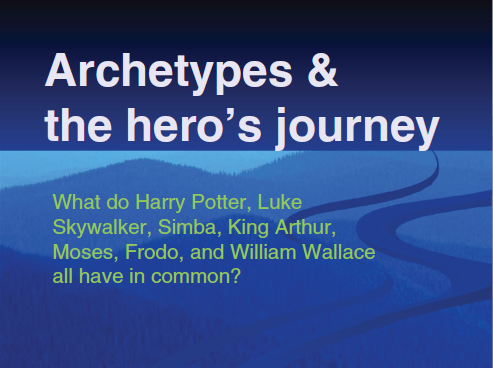
Carl Jung and Joseph Campbell are two of the most prominent explorers of the psychoanalytical and mythological origins for human and social behavior.
Carl Jung expanded the work of Sigmund Freud and the unconscious mind to emphasize the mythological forces working within the individual to shape his or her personality. Jung formed the concept of archetype and collective unconscious to explain the commonality of dream images and situations found in all people. Jung believed individual and social behavior and thought have their roots in a common palette of characters and situations the mind retains from early human consciousness development. To Jung, the archetypal hero represents the psyche’s quest for individuation, the process that makes each person unique.
Joseph Campbell built on Carl Jung’s concept of the collective unconscious to encompass all the world’s mythologies. Campbell studied the world’s religions, art, and stories and discovered common threads throughout all, including the hero. Campbell believed that mythology is the collective “dream” of mankind, the “song of the universe.” Campbell’s work highlights mankind’s common search, both personally and socially, for meaning and truth through the ages.
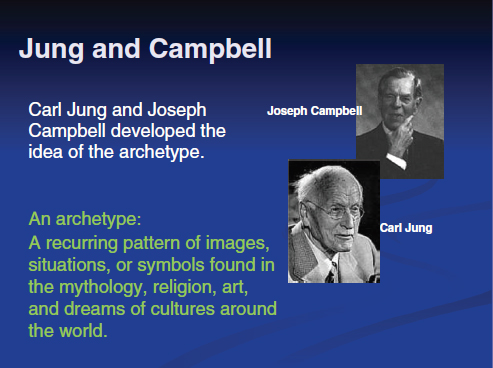
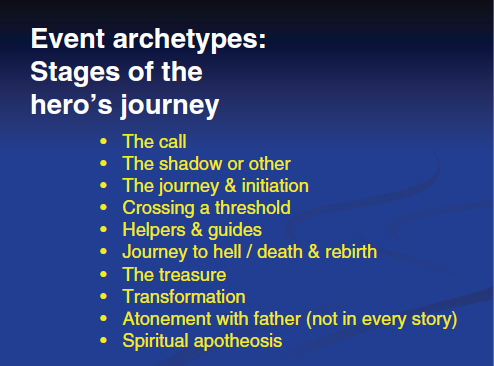

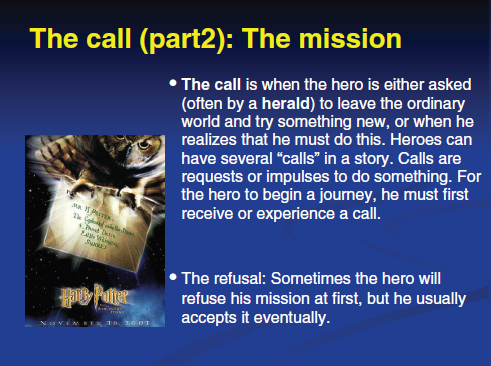
Simply put, an archetype is a recurring pattern of character, symbol, or situation found in the mythology, religion, and stories of all cultures. In the context of archetypes, Campbell defined his work as a search for “the commonality of themes in world myths, pointing to a constant requirement in the human psyche for a centering in terms of deep principles.” (The Power of Myth xvi). Jung defined his concept of the archetype as a formula that is the result of “countless experiences of our ancestors. They are, as it were, the psychic residue of numberless experiences of the same type” (quoted in Gordon ii). Both men felt that the experience of being human can be examined collectively across time, space, and culture, and that our commonality can be traced to the most primitive origins of the human consciousness, where the archetypal themes originate in modern men and women.
Archetypes can be thought of as the precursor to conscious thought, existing in the unconscious mind as expressions of psychic happenings, but without a basis in the physical world. Humans didn’t “invent” archetypes, but they do express archetypes in the conscious world of art, literature, and religion. Unconscious energies are given form in this way. Therefore, the hero is not someone “out there” in the world; he is all of us and our need to grow and mature.
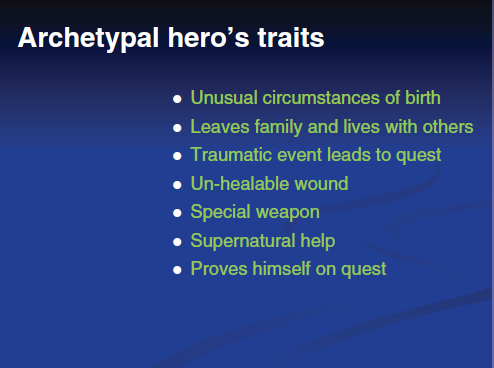
A hero’s birth will always have an unusual aspect to it. Many heroes are born to royalty or are in danger at birth. Either way, they are marked by these circumstances as different and destined for greatness.
Remember the beginning of The Lion King? Simba’s birth is being celebrated. The unusual aspect of his birth is his royal status. His father, Mufasa, is the King of the Pride Lands.
Moses wasn’t born into royalty like Simba, but he grew up in the Pharaoh’s household. The Pharoah had decreed that all Hebrew male babies under age two be killed, so Moses’ mother placed him in a basket on the Nile, where he was found by Pharaoh’s daughter.
Although viewers of Star Wars must wait until the second movie to find out the truth about Luke’s birth, hints about the unusual circumstances are given, such as the fact he lives with his aunt and uncle and didn’t know his parents.
King Arthur was not only born a prince, his father Uther Pendragon used Merlin’s wizardry to seduce Arthur’s mother, the wife of another man.
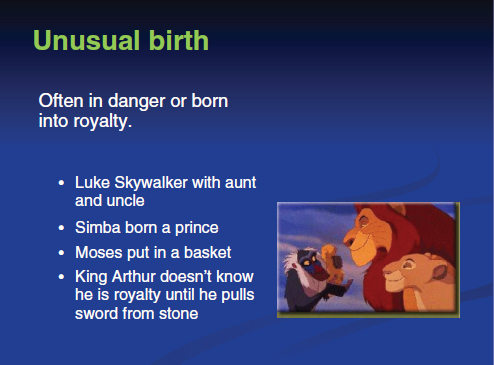
Sometimes the circumstances are traumatic that force the hero to leave home, as with Simba in The Lion King or Wallace in Braveheart, both of whom lose their fathers violently. With Luke in Star Wars and Arthur in the legends of King Arthur, the circumstances are more for protection than anything else. Either way, the hero must leave his home temporarily.
Simba’s father is murdered by Scar, but Simba is told that he is responsible, which forces our little hero to leave his kingdom. Have no fear, however, heroes always return to their land.
Moses also had to leave. Remember what he did that forced him out of Egypt? He slew an Egyptian slavemaster in anger. Now, granted, he was a man when this happened, but he still was forced out of his “land.” The hero has remained the same through time, even until today. Pretty neat, huh?
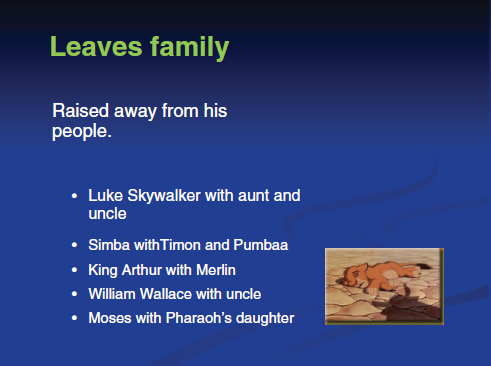
An event takes place that begins an adventure for the hero. Sometimes it is traumatic, like Wallace losing his wife in Braveheart, or it is coincidental, like Simba meeting Nala. Either way, the hero begins his adventure.
Simba initially fights with Nala, but they soon become friends. She tells him of Scar’s reign, which begins Simba’s quest to gain his father’s kingdom back from Scar.
William Wallace in Braveheart only begins to fight after his wife, Murron, is killed by the local British commander. Her death haunts him throughout the movie in addition to sparking the beginning of his quest for freedom.
King Arthur began his quest by drawing the sword from the stone (not Excalibur). Not traumatic of course, but surprising because Arthur was a lowly squire at the time.
Luke abruptly began his quest to fight the Empire when stormtroopers murder his aunt and uncle. Luke left the farm and never returned, going on to become a Jedi master.
Moses had nothing less than his god, Yahweh, appear in person to prompt Moses to go to Egypt and lead the Hebrews out of slavery.
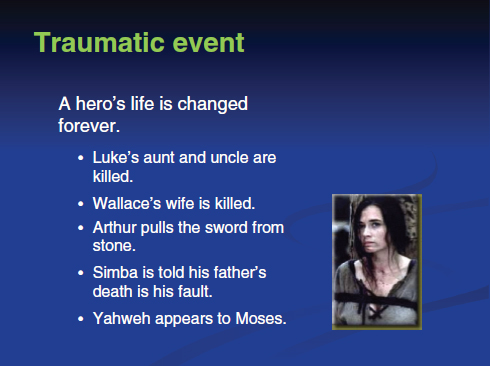
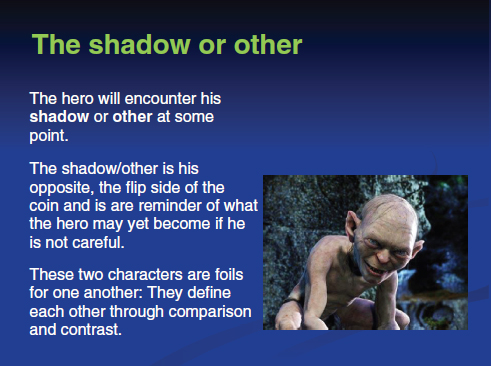
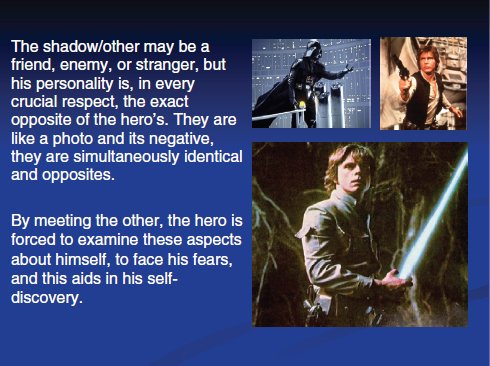
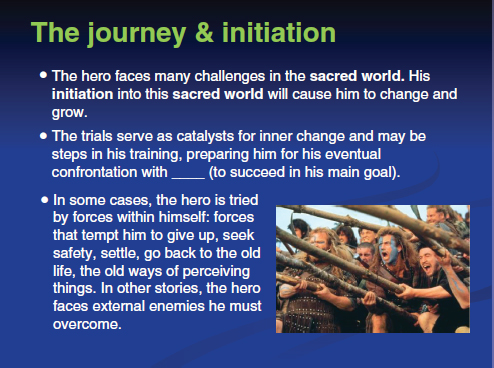
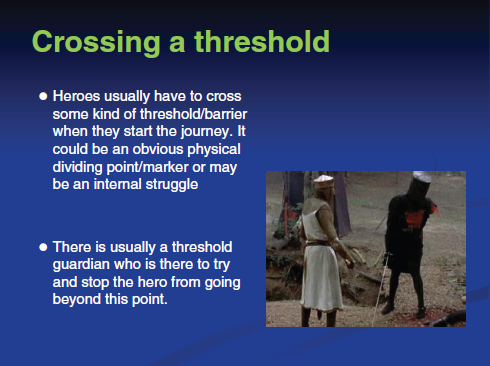
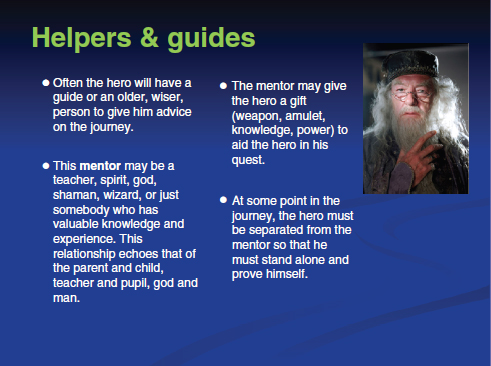
You can’t be a hero without a cool weapon, right? It’s true. In most hero stories, the hero has a special weapon, often one that only he can use.
Luke uses a lightsaber, an outdated weapon of the Jedi Knights, in Star Wars. Here’s Luke testing the lightsaber Ben has just given him. The saber belonged to Luke’s father. Only a Jedi can master this weapon.
Arthur received his sword Excalibur from the Lady of the Lake. When Arthur died, Excalibur was thrown back into the lake because only Arthur could wield this weapon.
Wallace’s sword didn’t appear to be anything special, but only he was allowed to carry it because it represented his power and prowess as a warrior.
Moses used his staff to perform miracles for Pharaoh, and also what Yahweh told him to raise to part and close the Red Sea.
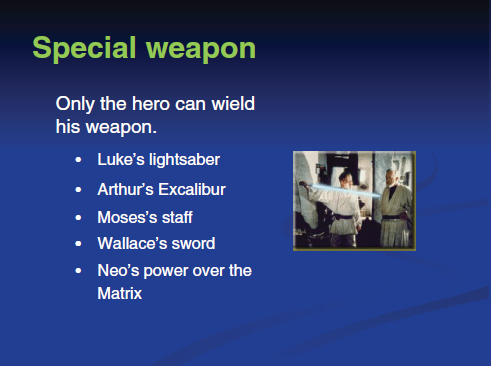
Heroes always seem to receive some sort of supernatural help, whether it be from a god, a wizard, or a spirit. Luke in Star Wars gets help from Ben even after Ben is slain by Darth Vader. When we first saw him in Star Wars, Ben healed Luke after Luke was attacked by the Sand People. Ben has many powers that make him a wizard-like character, similar to Merlin. Ben teaches Luke about the Force and later guides him from the spirit world.
Perhaps the most famous supernatural hero helper is Merlin, a wizard and counselor for King Arthur. Merlin is very powerful in sorcery and can even change shapes. His command of the supernatural world benefits Arthur both as a boy learning from Merlin and later as King.
Simba sees his father’s spirit and also gets helps from Rafiki, a medicine man–type character. Rafiki is the supernatural force in The Lion King. He doesn’t play as large a part as Merlin or Ben, but he does influence Simba and provide him with guidance.
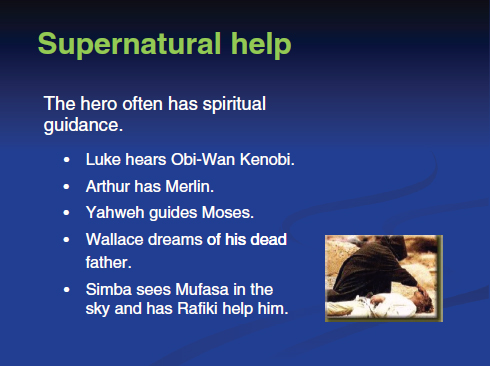
A hero just can’t claim he’s a hero and assume his position, now can he? The hero must prove to himself and others that he is the true hero. For instance, Moses performs many miracles to free his people from Egypt as well as help them survive the desert and reach Canaan.
Luke faces Darth Vader in battle several times during the Star Wars trilogy. These battles, along with other services Luke provides for the Rebellion, his training with Yoda, and his personal maturing are part of the trials he must successfully pass through to become the hero.
William Wallace’s success in battle against overwhelming odds, along with his political ability, help him to overcome the obstacles to freedom, which was his ultimate quest.
King Arthur’s success in battle, just like Wallace’s, is part of the proof of his heroic status. Leadership and courage allow the hero to overcome obstacles that lesser men could not. That’s the hero for ya!
Moses proves himself to the Pharaoh by performing miracles that the Pharaoh’s magicians cannot equal, showing Moses’ power through his god. Simba, like Luke, is immature at first and unable to be the hero he will eventually become. However, once Simba realizes Scar must be removed and Simba is the only one who can do it, Simba assumes his proper role as the hero and saves the land from the evil Scar. Hmm, that does sound just like Luke, doesn’t it?
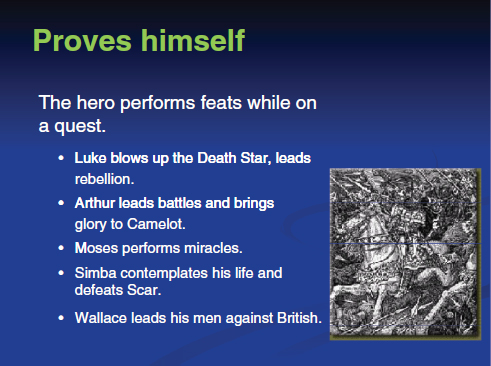
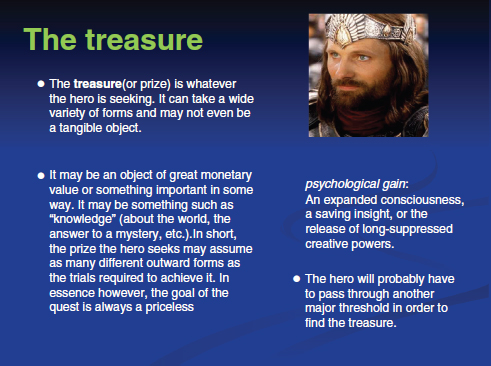
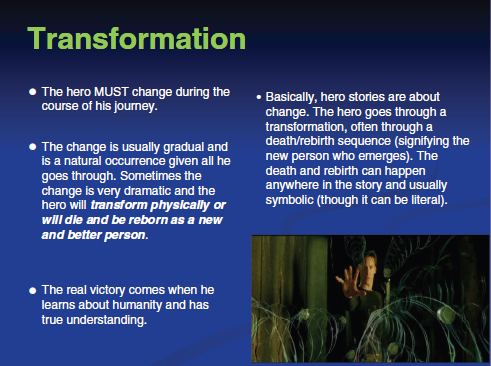
The hero is always on some type of adventure with a purpose—a quest if you will. He experiences many things on this quest, among which is a descent into a kind of “hell.” In this hell he experiences a low point in his life that leaves him scarred forever with a real or psychological wound that will not heal. The hero learns from this descent into “hell” much about himself and usually matures greatly from the experience.
Luke in Star Wars perhaps illustrates this stage best. His quest, without knowing it at first, is to rescue his father from the dark side of the Force. Luke’s descent into hell occurs when he decides to rescue his friends trapped in Lando Calrissian’s Cloud City. Luke leaves his Jedi training before it is completed to perform this rescue. Luke is not prepared to face Darth Vader, who is waiting for him at Cloud City.
Darth Vader plans to trap Luke in the carbon-freeze chamber in Cloud City. In the duel that takes place between Luke and Darth in this chamber and beyond, Luke loses his hand and chooses to jump to almost certain death rather than give in to Vader’s proposal to join the dark side of the Force. Luke’s loss of his right hand in the duel is his Un-healable Wound. Clearly, this is the lowest point in Luke’s journey to become a Jedi Knight and save his father. His wound and this low point teach him about himself, however, and eventually help him to become a true hero.
Other heroes suffer low points in their journeys. Arthur never recovers from the affair Guinevere has with Lancelot. William Wallace knew his execution would make him a martyr, so he was courageous as he was in his “hell”—the dungeon. Moses’ doubt of himself and Yahweh cause him to suffer his Un-healable Wound: denial of entry into the Promised Land. Simba’s descent into “hell” is combined with his defeat of Scar and the hyenas. Remember all the flames in the background as he fights Scar? He symbolically goes where none of the other lions could go in order to help his pride and prove himself. Simba’s Un-healable Wound? His past, where his courage failed him and his pride, will always haunt him.
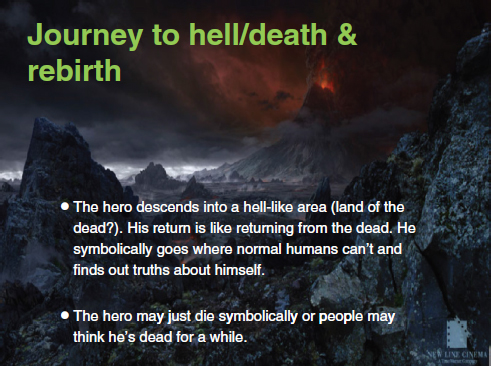

After the hero’s journeys are over, the hero is rewarded spiritually in some way. Normally, the hero achieves a life in bliss, often in a place with other heroes, like Valhalla or the Isle of the Blessed from mythology.
Examples differ widely at this point. Although the movie version of his life takes many liberties, the real William Wallace lives on in the spirit of his country. There is no indication of what happens to Simba but we can infer from the appearance of his father’s spirit that immortality awaits him.
Arthur is called the “Once and Future King” for good reason. When Arthur died he was placed on his funeral ship, his body set adrift to let the sea carry him off, but he is promised to return one day to reclaim his throne of England. This promise implies his spirit is waiting somewhere and is not really dead, his reward for his sacrifice as king.
And even though he didn’t get into the Promised Land, Moses’ service to Yahweh gained him the spiritual reward of heaven.
Obi-Wan, Yoda, and Anakin Skywalker appear together in spirit form: They all were Jedi Knights and are now rewarded spiritually for being on the Good Side of the Force, implying that a Jedi like Luke will be rewarded when his body dies.
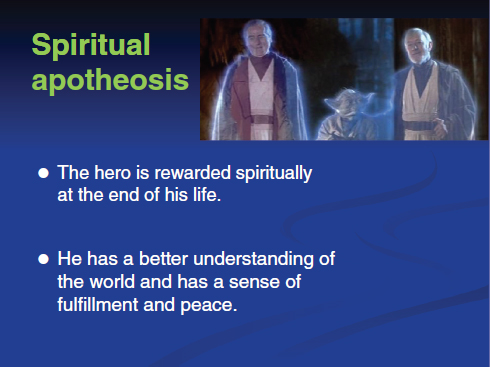
Atonement means to offer payment for a wrongdoing. Very often, heroes must avenge a father or make up for the father’s evil. William Wallace’s revolt was driven in part to avenge his father’s death in the war with England. Indeed, the father’s ghost haunts Wallace’s dreams throughout the movie.
Moses’ “father,” Yahweh, doesn’t allow Moses into the Promised Land as a way of Moses atoning for his doubt, a situation that reverses the traditional atonement by the hero for the father.
The spirit of Mufasa, Simba’s father, tells Simba to be strong and assume his place on the throne. Simba, who has been reluctant up to this point to return to his kingdom, realizes he has little choice but to avenge his father’s murder.
Arthur’s father, Uther Pendragon, is unscrupulous and lustful. He uses his power to satisfy his personal urges, fathering Arthur deceitfully with a woman under a spell of Merlin that makes her think Uther is her husband. He looks a bit on the evil side, doesn’t he? His father’s evil legacy puts Arthur in a position to atone for his father’s sins and be a good king, helping his people with selfless service.
Luke’s ultimate quest is rescuing his father from the evil of the Dark Side. Here, Luke consoles his dying father after his father saves Luke and atones for his own past by killing the Emperor, the leader of the Empire. Much like Arthur, Luke chooses to be good, the opposite of what the father chose, and therefore atones for the father’s sins.
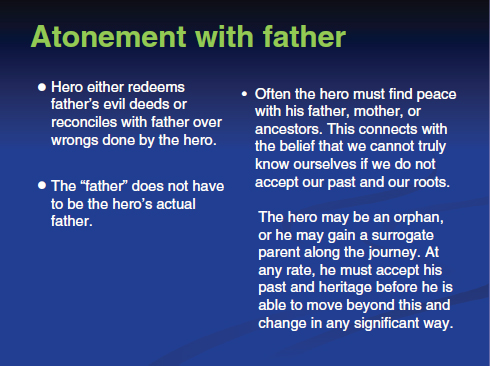
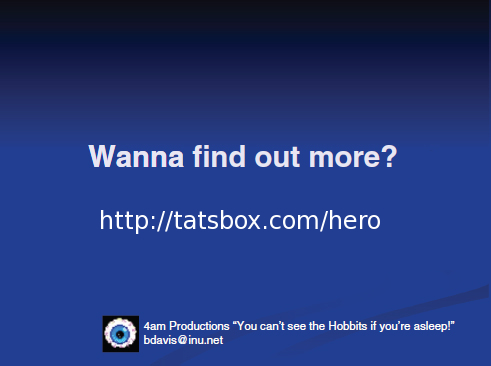
Works Cited
Breen, Myles, and Farrel Corcoran. “The Myth in the Discourse.” Annual Meeting of the Central States Speech Association. Milwaukee. 15–17 Apr. 1982. Lecture.
Burke, Ken. “Mythical Structures in Community Vision.” Annual Meeting of the Central
States Communication Association. Cleveland. 9–12 Apr. 1992. Lecture.
Campbell, Joseph. The Hero with a Thousand Faces. Princeton: Princeton University Press, 1949. Print.
Campbell, Joseph, and Bill Moyers. The Power of Myth New York: Doubleday, 1988. Print.
Davies, Robert, James Farrell, and Steven Matthews. “The Dream World of Film: A Jungian Perspective on Cinematic Communication.” Western Journal of Speech Communication 46.4 (1982): 326–43. Print.
Gordon, Walter. Literature in Critical Perspectives New York: Meredith Corp., 1968. Print.
Prentice, Penelope. “Tell Me a Story I’ll Never Forget or Deconstructing Traditional Narrative Plot/Myths to Challenge the Ethics of Conflict.” Annual Meeting of the College English Association. Pittsburgh. 27–29 Mar. 1992. Lecture.
Valesio, Paolo. “The Beautiful Lie: Heroic Individuality and Fascism.” Reconstructing Individualism: Autonomy, Individuality, and the Self in Western Thought. Ed. Thomas Heller, Morton Sosna, and David E. Wellbery. Stanford: Stanford UP, 1986. 163–83. Print.
Wilkerson, Norma. “Archetype in Fiction and Film.” College Board Vertical Teams AP English Conference. Hotel Sofitell, Houston. 15 Nov. 1997. Lecture.
Williams, Raymond. Marxism and Literature. Oxford: Oxford UP, 1989.